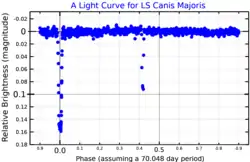 A light curve for LS Canis Majoris from BRITE nanosatellite data, adapted from Ratajczak et al. (2019)[1] | |
| Observation data Epoch J2000 Equinox J2000 | |
|---|---|
| Constellation | Canis Major |
| Right ascension | 07h 01m 05.94626s[2] |
| Declination | −25° 12′ 56.2817″[2] |
| Apparent magnitude (V) | 5.63 – 5.79[3] |
| Characteristics | |
| Spectral type | B2/3III/IV[4] |
| Variable type | Eclipsing binary[3] |
| Astrometry | |
| Radial velocity (Rv) | 6.0[5] km/s |
| Proper motion (μ) | RA: −4.638[2] mas/yr Dec.: +5.332[2] mas/yr |
| Parallax (π) | 2.1591 ± 0.0613 mas[2] |
| Distance | 1,510 ± 40 ly (460 ± 10 pc) |
| Absolute magnitude (MV) | −2.04[6] |
| Other designations | |
| Database references | |
| SIMBAD | data |
LS Canis Majoris is an eclipsing binary star located around 1,510 light years from Earth in the constellation Canis Major. Its apparent magnitude ranges from 5.63 to 5.79. The orbital period of binary pair and the period of light variation is 70.048 days.[1]
References
- 1 2 Ratajczak, M.; Pigulski, A.; Pavlovski, K. (May 2019). "Tracking massive pairs". Contributions of the Astronomical Observatory Skalnaté Pleso. 49 (2): 252–257. Bibcode:2019CoSka..49..252R. Retrieved 15 November 2021.
- 1 2 3 4 5 Vallenari, A.; et al. (Gaia collaboration) (2023). "Gaia Data Release 3. Summary of the content and survey properties". Astronomy and Astrophysics. 674: A1. arXiv:2208.00211. Bibcode:2023A&A...674A...1G. doi:10.1051/0004-6361/202243940. S2CID 244398875. Gaia DR3 record for this source at VizieR.
- 1 2 "LS CMa". International Variable Star Index. AAVSO. Retrieved 2022-08-29.
- ↑ Houk, N.; Smith-Moore, M. (1988). "Catalogue of two-dimensional spectral types for the HD stars, Vol.4". Michigan Spectral Survey. 4. Bibcode:1988mcts.book.....H.
- ↑ Kharchenko, N. V.; et al. (2007). "Astrophysical supplements to the ASCC-2.5: Ia. Radial velocities of ~55000 stars and mean radial velocities of 516 Galactic open clusters and associations". Astronomische Nachrichten. 328 (9): 889. arXiv:0705.0878. Bibcode:2007AN....328..889K. doi:10.1002/asna.200710776. S2CID 119323941.
- ↑ Melnik, A. M.; Dambis, A. K. (2020). "Distance scale for high-luminosity stars in OB associations and in field with Gaia DR2. Spurious systematic motions". Astrophysics and Space Science. 365 (7): 112. arXiv:2006.14649. Bibcode:2020Ap&SS.365..112M. doi:10.1007/s10509-020-03827-0. S2CID 220128144.
- ↑ "LS Canis Majoris - Eclipsing Binary". SIMBAD Astronomical Database. Centre de Données astronomiques de Strasbourg. Retrieved 2 March 2014.
This article is issued from Wikipedia. The text is licensed under Creative Commons - Attribution - Sharealike. Additional terms may apply for the media files.